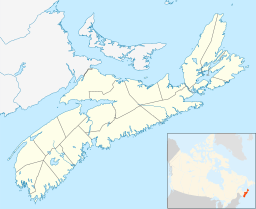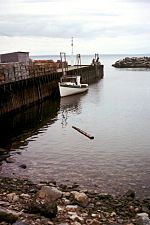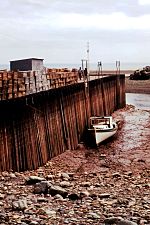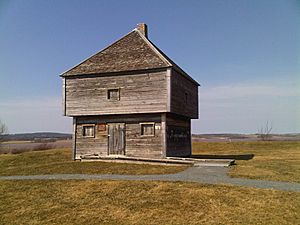Bay of Fundy facts for kids
Quick facts for kids Bay of Fundy |
|
|---|---|
| Baie de Fundy | |
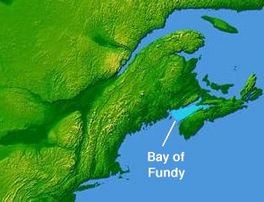
The Bay of Fundy
|
|
| Location | New Brunswick, Nova Scotia, Maine |
| Coordinates | 45°00′N 65°45′W / 45.000°N 65.750°W |
| Type | Estuary |
| Etymology | Likely from the French Fendu, meaning "split". |
| Primary inflows | Canada and USA |
| River sources | Big Salmon, Magaguadavic, Memramcook, Petitcodiac, Quiddy, Saint John, St. Croix, Upper Salmon, Annapolis, Avon, Cornwallis, Farrells, Salmon, Shubenacadie, Kennetcook |
| Primary outflows | Gulf of Maine |
| Ocean/sea sources | Atlantic Ocean |
The Bay of Fundy (French: Baie de Fundy) is a large bay located between the Canadian provinces of New Brunswick and Nova Scotia. A small part of the bay also touches the U.S. state of Maine. It is known for having the highest tidal range in the world. This means the difference between high tide and low tide is bigger here than anywhere else! The name "Fundy" likely comes from the French word fendu, which means 'split'.
Amazing Tides of Fundy
What Makes Tides So High?
The Bay of Fundy has tides that can reach about 16 metres (52 ft) high. To give you an idea, the average tide around the world is only about one metre (3.3 ft)! The exact height of the tides changes a bit each day. It depends on the position of the Moon and Sun, and even the weather.
The Bay of Fundy has two high tides and two low tides every day. This is called a "semidiurnal" tide. There are about six hours and 13 minutes between each high and low tide.
How Water Moves In and Out
The bay is shaped like a funnel, which makes the tides incredibly powerful. In just one 12-hour tidal cycle, about 100 billion tonnes of water flow in and out of the bay. That's twice as much water as all the rivers in the world combined!
Because of this huge amount of moving water, some people have tried to use it to make electricity. The Annapolis Royal Generating Station in Nova Scotia was one of the few places in the world that used tidal power. It generated 20 MW of electricity until it closed in 2019.
Cool Tidal Events
Many rivers flowing into the Bay of Fundy have a special event called a tidal bore. This is a wave of incoming tide that pushes its way up a river, going against the river's normal flow. You can see tidal bores on rivers like the Petitcodiac, Maccan, and Kennetcook.
The Petitcodiac River once had one of the biggest tidal bores in the world, up to two metres (6.6 ft) high! After a causeway was built in 1968, the bore almost disappeared. But since the causeway gates were opened in 2010, the bore has returned. In 2013, surfers rode it for a record-breaking 29 kilometres (18 mi)!
Other amazing tidal events include the Reversing Falls near the city of Saint John, New Brunswick. Here, the powerful tides make the river flow backward! There's also the Old Sow whirlpool in Passamaquoddy Bay, which is one of the largest whirlpools in the Western Hemisphere.
Fundy's Ancient Past
The story of the Bay of Fundy began about 200 million years ago. At that time, all the land on Earth was part of a giant supercontinent called Pangaea. The area that is now the Maritimes (New Brunswick and Nova Scotia) was near the equator. It had a warm, tropical climate with lots of plants.
As Pangaea slowly broke apart, huge cracks formed in the Earth's crust. These cracks are called rift valleys. Hot, melted rock (magma) erupted from these cracks, forming igneous rock like the cool columnar jointing you can see on Brier and Grand Manan islands. These rocks sometimes contain beautiful minerals like agate and amethyst.
Over millions of years, these rifts filled with sand and mud, which turned into sedimentary rock. Many incredible fossils have been found along the Fundy shoreline. The oldest dinosaur fossil ever found in Canada was discovered at Burntcoat Head. Very old reptiles have been found inside ancient tree trunks at Joggins. Wasson Bluff is another place rich with Jurassic fossils.
The Bay of Fundy area is part of the Global Geoparks Network. This is a UNESCO program that helps protect and share important geological sites around the world.
Amazing Animals and Nature
The Bay of Fundy is home to many different animals, especially marine life. Even though there isn't a special protected area for the marine parts of the bay, groups like the Conservation Council of New Brunswick work hard to protect its ecosystem.
Whales and Other Marine Mammals
The bay is a very important feeding ground for the critically endangered North Atlantic right whale. Sadly, these whales can sometimes get hit by ships. To help protect them, the Canadian Coast Guard changed shipping lanes in 2003 to avoid the main whale feeding areas.
Many other marine mammals also live in the bay. These include fin whales, humpback whales, minke whales, Atlantic white-sided dolphin, and the harbour porpoise. It's a great place for whale watching!
Unique Mudflats and Birds
The Bay of Fundy is famous for its huge intertidal mudflats. These are areas of mud that are covered by water at high tide and exposed at low tide. Major mudflats are found around the Maringouin Peninsula and in the Minas Basin. In the Minas Basin, the mudflats can stretch as far as 4 km (2.5 mi) from the low to high water marks!
The water in these areas carries a lot of fine mud. This mud comes from the erosion of old rocks. Tiny plants like hollow green weed, phytoplankton, and algae grow here.
These mudflats are super important for birds. Many protected areas have been set up to help them:
- Boot Island National Wildlife Area
- Chignecto National Wildlife Area
- Grindstone Island Conservation Easement
- Isle Haute
- John Lusby Marsh National Wildlife Area
- Raven Head Wilderness Area
- Shepody National Wildlife Area: This area is very important for birds. It's recognized internationally for its wetlands and is a key stop for migrating birds. The most common bird here is the semipalmated sandpiper.
- South Wolf Island Nature Preserve
- Tintamarre National Wildlife Area
People and History of Fundy
A Rich History
For centuries before Europeans arrived, the Miꞌkmaq people fished and lived in communities around the Bay of Fundy. According to Mi'kmaq legend, the tides were created when the great spirit Glooscap wanted to take a bath!
The first European to visit the bay might have been a Portuguese explorer named João Álvares Fagundes around 1520. The first European settlement was French, founded at Saint Croix Island in Maine, and then Port Royal in 1605. This settlement was started by Pierre Dugua and Samuel de Champlain. Champlain named the bay Labaye Francoise (The French Bay).
Port Royal was the first lasting European settlement north of Spanish Florida. It was built two years before the first British settlement in Jamestown, Virginia. About 75 years later, French settlers called Acadians spread out along the bay. They founded communities like Grand-Pré and Beaubassin.
There were many battles around the bay as the French and British fought for control. This led to the expulsion of the Acadians, where many French settlers were forced to leave their homes. Later, Americans also attacked settlements during the American Revolution and the War of 1812.
Shipping and Famous Ships
In the 1800s, the Bay of Fundy was a very busy place for shipping. Many ships were built here. Famous shipbuilders included James Moran and William D. Lawrence.
Fundy ports produced some amazing ships:
- The Marco Polo was the fastest ship in the world.
- The William D. Lawrence was the largest wooden ship ever built in Canada.
- The mysterious ship Mary Celeste was also built here.
The Bay of Fundy was also home to the first female sea captain in the Western world, Molly Kool.
The highest water level ever recorded in the bay was 21.6 metres (71 feet) in October 1869. This was caused by a huge storm called the Saxby Gale, which happened at the same time as a very high tide. It caused a lot of damage to towns and ports.
Towns and Cities
The biggest city on the Bay of Fundy is Saint John, New Brunswick. It's a major port and was the first city in what is now Canada to be officially recognized.
Other towns and communities along the bay include:
- In New Brunswick: St. Andrews, Blacks Harbour, Grand Manan, Campobello, Fundy-St. Martins, Alma, Hopewell Cape, and Sackville.
- In Nova Scotia: Amherst, Advocate Harbour, Parrsboro, Truro, Maitland, Windsor, Wolfville, Annapolis Royal, and Digby.
Ports and Ferries
The port of Saint John is important for the pulp and paper industry and the Irving oil refinery. Hantsport, Nova Scotia, also has a pulp and paper mill and ships gypsum to the United States.
Many ferries cross the bay, connecting different communities:
- From Saint John to Digby (operated by Bay Ferries).
- From Grand Manan to Blacks Harbour and White Head Island (operated by Coastal Transport).
- The Letete to Deer Island Ferry.
- From Campobello Island to Deer Island and Eastport, Maine to Deer Island.
- From Brier Island to Long Island and Long Island to mainland Nova Scotia.
Gallery
-
The Minas Basin in early May
-
Reversing Falls is where the Saint John River and Bay of Fundy meet.
-
Basal contact of a lava flow section of Fundy basin
See also
 In Spanish: Bahía de Fundy para niños
In Spanish: Bahía de Fundy para niños


